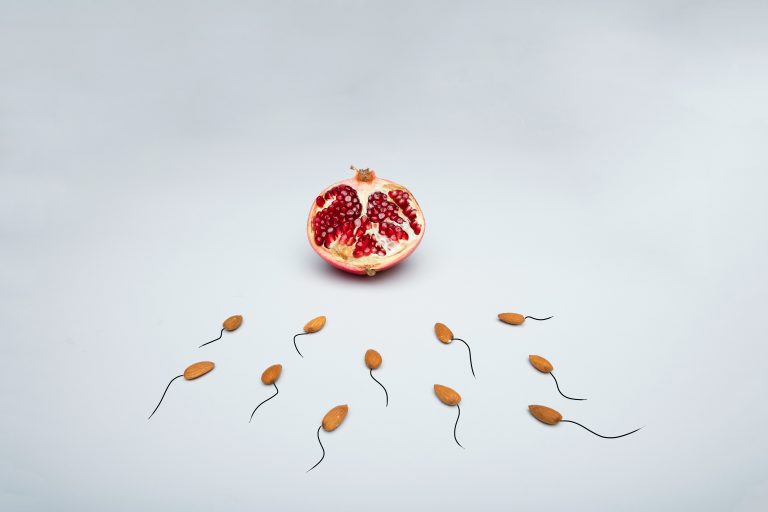

You might well wonder what gut health has to do with hormonal health, but, as with most things in the body, these are intrinsically linked.
Why gut health = hormone health
When our gut is working properly, we’re better able to regulate hormones like oestrogen and testosterone, as well as clearing out old, ‘used up’ hormones from our system (which we do by pooing regularly).
Although we don’t know exactly how they do it yet, our clever gut microbes have a really key role in hormone regulation, as well as reducing inflammation. Specifically, there’s a whole family of microbes in our gut called the ‘estrobolome‘, which help us to regulate oestrogen, our main female sex hormone.[1] The estrobolome produces an enzyme called beta-glucuronidase, which helps to turn oestrogens back into their active forms. This is helpful for perimenopausal and menopausal women, as this can boost the production of free oestrogen that’s capable of binding to our oestrogen receptors, potentially reducing menopausal symptoms.[1] The estrobolome may also provide insight into the treatment and management of endometriosis, infertility and other oestrogen-mediated, female reproductive disorders.[2]
The bottom line: We want to make sure we’re pooing regularly and nourishing our gut microbes for optimal female hormone health.
So forget Spring Cleaning your home, now is the perfect time to give your gut a good old Spring Clean, for improved hormone health and more.
So what does a gut Spring Clean entail? Why would we do it, and how can we do it safely?
As you may know, our gut has trillions of bacteria, fungi and other microorganisms living in it – known as our gut microbiota. A beautiful symbiotic relationship exists between us and our gut microbiota, where we feed it the dietary fibre we can’t digest, and it gives off bi-products like short chain fatty acids. As well as being supportive of hormonal health, these bi-products have all sorts of health benefits, including for inflammation, energy levels, appetite, setting our circadian rhythm (body clock), and our immune response.[3]
That’s when everything is working well, but what happens when our gut microbiota is imbalanced (known as dysbiosis)? An imbalanced microbiota can contribute to health issues like metabolic, cardiovascular, gastrointestinal and neurodegenerative diseases, and cancer[3], and can drive diseases associated with low oestrogen levels.[1] There is evidence that dysbiosis is associated with several gynecologic conditions, with links to the microbiome and conditions like endometriosis and infertility.[2]
While there’s no ‘perfect’ gut microbiome, we want to make sure it’s as balanced as possible – with plenty of the good bacteria, limited amounts of opportunistic bacteria (bacteria that might get out of control if allowed to grow unchecked), and ideally no pathogenic (bad) bacteria.
So how do we make sure our gut bacteria is balanced?
This is where our gut Spring Clean comes into play. This is a staged plan, where the aim is to focus on foods that allow our good bacteria to flourish, while limiting the number of opportunistic and pathogenic bacteria.
But before you dive in, it’s really important to make sure to you’re doing this as slowly and gently as possible, as going too hard too soon might leave you feeling worse!
So get ready for the gut Spring Clean:
Step 1: Reduce your sugar intake
Too much sugar can lead to an imbalanced gut bacteria, so you want to cut out as much of the refined sugars as possible over a couple of weeks at least. This would involve cutting right back on things like:
- Cakes, biscuits, muffins, breakfast cereals, snack bars and other sweet treats
- White flour products like bread and pastry
- White rice and pasta
- Fizzy drinks, fruit juice, cordials and alcohol
- Sugar in honey and syrups (even if these are ‘natural’ sugars, they’re still sugar!)
Slow and steady wins the race on this one, as drastically cutting out all sugar from your diet might leave you feeling worse than before – think headaches, cravings, mood disturbances and tiredness.
Need some help with the sugar cravings? One of our favourites for this is Viridian’s Chromium & Cinnamon Complex, with ingredients like chromium, cinnamon and alpha lipoic acid, designed to help support the maintenance of normal blood sugar levels.
During this time, it’s really important to make sure you’re eating plenty of protein and fibre – so lots of fresh, colourful vegetables, leafy greens, some wholegrains like quinoa, oats and bulgur wheat, and lean protein like chicken, fish, legumes, beans, nuts and seeds. Rather than thinking of what you can’t have, focus on all the lovely, fresh produce that you can have.

Step 2: Rebalance the gut microbiome
Once you’ve done step 1, we can look to reduce any pathogenic bacteria in our gut, to promote a healthy, balanced gut bacteria. One way of doing this is through eating more anti-microbial plants, to help reduce pathogenic bacteria and allow the beneficial bacteria to flourish. Especially good for this are garlic, rosemary, ginger, thyme, clove, cinnamon, oregano, liquorice, turmeric, olive oil and coconut oil.
Another way to do this is through supplementation. I love Living Nutrition’s SIBO-Go – a combination of garlic, oregano, thyme and cloves.
Step 3: Reinoculate the gut
Once you’ve reduced your sugar content and pathogenic bacteria, now is the time to put back the good bacteria into the gut. Again, this can be done with diet and/or supplementation. The best foods for this are those that contain ‘live’ bacteria – think foods like live yogurt, kefir, sauerkraut, kimchee, kombucha, fermented olives, tempeh, and miso.
If fermented foods aren’t your thing, there are some brilliant probiotic supplements available. A few of my favourites are:
- Viridian Synerbio – a formulation of friendly bacteria, with added prebiotic fibre to support gut flora.
- Living Nutrition Regenesis – made with fermented soy, with over 100 different strains of bacteria.
- Terranova Fermented Kombucha – all the benefits of kombucha in a capsule!
You also want to make sure you’re feeding the good bacteria that you’ve just put in, so keep going with plenty of colourful plant foods (the more diverse the better!).
The final word on the gut Spring Clean…
Everyone is different, and there can be lots of different things (or a combination!) going on in our gut that are causing symptoms. It may be that you need some extra help with this – if you do, I’d recommend talking to a registered Nutritional Therapist to guide you through. If you’re curious, message me and book in for your free 30 minute nutritional therapy consultation.
Please note, this blog should not be taken as medical advice, and the supplements recommended may not be suitable for everyone, especially if you’re on prescribed medication. If you have any health concerns, please consult your GP.
References
- Baker JM, Al-Nakkash L, Herbst-Kralovetz MM. Estrogen–gut microbiome axis: Physiological and clinical implications. Maturitas. 2017 Sep 1;103:45-53.
- Salliss ME, Farland LV, Mahnert ND, Herbst-Kralovetz MM. The role of gut and genital microbiota and the estrobolome in endometriosis, infertility and chronic pelvic pain. Human reproduction update. 2022 Jan 1;28(1):92-131.
- Liu J, Tan Y, Cheng H, Zhang D, Feng W, Peng C. Functions of gut microbiota metabolites, current status and future perspectives. Aging and Disease. 2022 Jul 7;13(4):1106.




